The Pond Life That We Can and Can’t See
Our ponds are teaming with life that we can see and with life that we cannot see. Sometimes, we lose sight of just how important and impactful our little corner of nature that we call our backyard can be. Our world as we know it today couldn’t exist without all of the life and diversity in its aquatic ecosystems, and our little backyard ponds are one piece of this very diverse puzzle of life.
As pond owners, we often focus on the fish, frogs, plants, and algae in our ponds, but I think we often forget about the many other living things in our ponds.
The Life that We Can’t See
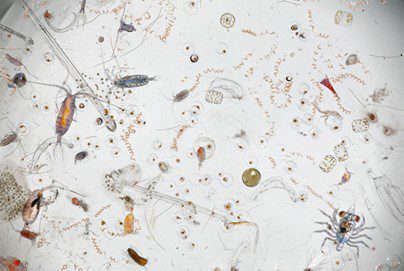
A good portion of the life in our ponds can’t even be seen without using a microscope. Our ponds are teaming with life that most of us don’t even know exists. I believe that if we could see all of the microorganisms in our ponds, we would be much less likely to add chemicals to our ponds. If a chemical isn’t killing our aquatic marginal plants and water lilies and it isn’t killing our fish and frogs, then is it safe to use? To answer this question, we must understand how complex and diverse our pond ecosystem is.
What are Microorganisms?
In general, microorganisms are living organisms that can’t be seen with the naked eye; we can only see them under a microscope. The terms microorganism and microbe can be used interchangeably and mean the same thing.
Marine microorganisms are defined by their habitat as living in an aquatic environment. There are many types, and they can be single-celled or multicellular. They include bacteria, archaea, viruses, protozoa, fungi, algae, and animals, such as rotifers and copepods.
It is estimated that marine microorganisms make up about 70%—90% of the ocean’s biomass. This massive and diverse system of microbes is crucial for decomposing debris and cycling carbon, nitrogen, phosphorus, and other nutrients worldwide. These microbes also produce much of the world’s oxygen.
Because this ecosystem of organisms that we can’t even see is so wide-ranging and essential to our earth, I think it is vital that we stop inadvertently killing them with chemicals.
Before adding another drop of algaecide to your pond, consider the effects it might have on the life you can’t see.
The Types of Microbial Life
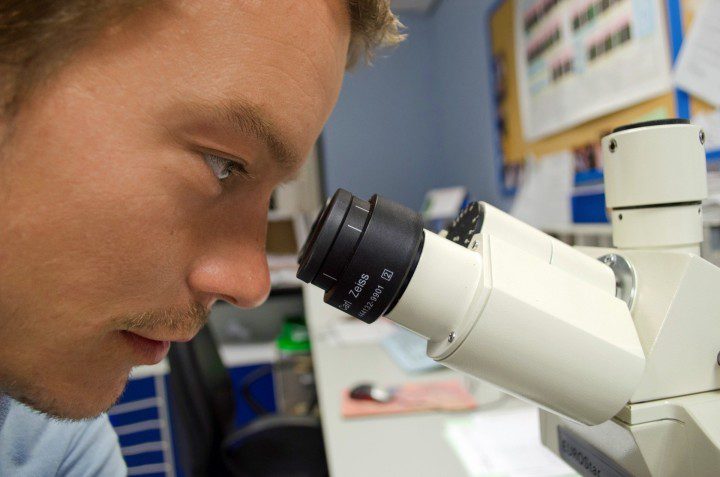
Each type of microbe plays its own role in our pond ecosystem. Some live in the upper areas of the pond and use sunlight for photosynthesis; others live deeper in the pond and work to break down debris. No matter where they are, they are essential to the balance and health of our pond water.
When we look into our ponds and see an overabundance of algae, we should wonder why our pond water is out of balance. We shouldn’t be wondering how to kill the algae and, along with it, a bunch of microorganisms.
- Bacteria – Bacteria are the workhorses of the pond world. Every pond contains bacteria, and the bacteria shoulder the brunt of the responsibility of keeping our pond ecosystem in balance.
- Fungi – Fungi occur as single cells and in filaments called hyphae. They are critical to the balance of our ponds because they can decompose plant matter such as cellulose and lignin.
- Protozoa – Protozoa are microscopic, single-celled organisms that sometimes group together into colonies that we call biofilm. They consume other organisms, such as algae, bacteria, or other protists.
- Algae – Yes, algae are important microorganisms also. Algae is an informal term used to describe microorganisms that carry out photosynthesis. Algae can vary in size from microscopic to large colonies. Several types of algae play an essential role in supplying the energy at the base of many aquatic food webs.
- Phytoplankton – Phytoplankton are tiny, microscopic plants that live suspended in the open water. They can exist as single cells, chains, or colonies and are direct food sources for many zooplankton and some fish.
- Periphyton and Biofilm – These terms are generally used to describe the slippery stuff that forms on everything underwater. This is made up of layers of dying cells, algae, bacteria, fungi, and protozoa. The term periphyton usually refers to a layer consisting mainly of algae; all of the layers together are usually called biofilm. These layers of microorganisms are important food sources for snails, insects, and fish. Biofilm helps to absorb and break down chemicals also.
When Your Pond Loses Microbial Balance
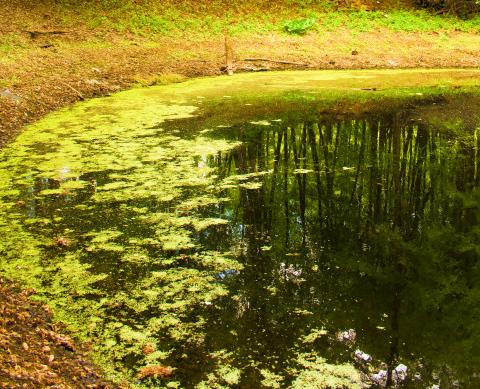
When your pond loses its balance due to excessive nutrients entering the pond or due to chemicals entering the pond that kill off important microorganisms, it makes your pond susceptible to the bad microbes. The imbalance creates an environment that is more favorable to the types of microbes that are less desirable. Pathogenic bacteria can thrive in aquatic ecosystems with poor water quality and excess organic matter. Certain pathogenic bacterial species can stunt fish growth and even cause fish mortality. This is why it is so important to keep our ponds healthy and well-aerated to let the beneficial microbes do their job and keep our water healthy.
In general, a pond that is exposed to more stress is more susceptible to going out of balance. Anything that negatively affects the microbial community stresses the balance of your pond.
Here are some of the things that may stress your pond balance:
- Fertilizers and pesticides or herbicides from your lawn and flower beds.
- Mulch from surrounding flower beds.
- Driveway or road runoff.
- Algaecides.
- Excessive dirt entering the pond due to erosion.
- Dead animals decaying in the pond.
The Life that We Can See
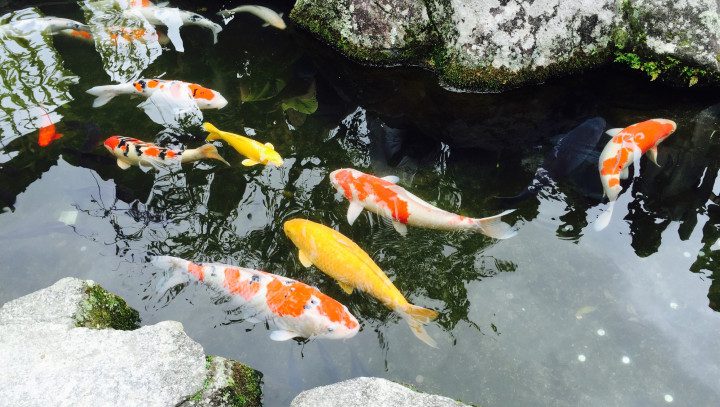
Much of the life in the pond is evident and hard to miss, like our beautifully colored fish, the hopping frogs, and the colorful water lilies and Iris. On the other hand, there is a lot of life that is much less evident. We can still see it, but we need to look a bit harder.
Macrophytes (Big Plants)
Macrophytes are quite literally the large aquatic plants that grow in our ponds. These plants are usually categorized based on where and how they grow. Aquatic plants add complexity to our pond’s ecosystem and provide habitat, refuge, food, and spawning areas for all of our pond inhabitants and visitors.
Rooted macrophytes – These plants are what we often refer to as marginal pond plants because they typically grow along the margins of a body of water. Their roots are fully submerged in the water, but the leaves and stems might be mostly under or mainly above the water. These rooted plants absorb nutrients, chemicals, and heavy metals from our ponds. Rooted plants are the most important part of our upflow wetland filters. While rooted plants are an important piece of the ecosystem of our ponds, they can also be detrimental if allowed to spread too much. I’m sure that you have noticed how many shallow, natural bottomed ponds fill in over time due to the plant’s aggressive growth.
Floating aquatic macrophytes – These are the plants that float on the top of the water with no roots connecting them to the pond bottom. Plants such as duckweed and floating hyacinth are examples that you may be familiar with. Once again, having some of these plants in our pond is advantageous, but they can certainly spread too quickly and be detrimental to our ponds if left unchecked.
Riparian Vegetation
These plants grow at the pond edge, with some roots in the water and some out of the water. They are important for our ponds because they remove nutrients from the water and also keep nutrients from entering our pond by acting as a barrier to runoff. Riparian plants can vary greatly, from grasses and perennial plants to shrubs and trees.
Aquatic Organisms: Invertebrates
These are all of the pond animals that do not have a backbone. These animals are a very abundant and diverse group, including animals such as flatworms, roundworms and segmented worms, snails, dragonflies, mayflies, stoneflies, caddisflies, mosquitoes, beetles, midges, crayfish, and zooplankton. These animals are crucial to the health of our ponds because they are numerous and diverse, and they feed on the debris and biofilm. These animals are also a crucial link in the food chain for the larger animals that visit our pond. Scientists use this community as an indicator of ecosystem health due to their sensitivity to pollution and environmental changes.
Aquatic Organisms: Vertebrates
All animals that have a backbone are called vertebrates. These are the critters that we are most familiar with, such as fish, amphibians, reptiles, mammals, and birds.
Fish
In our ponds, we typically see goldfish and Koi, which will eat just about anything on the pond’s bottom. Having these fish in our ponds helps to keep the algae and duckweed at a minimum and stirs up the bottom a bit, which helps the debris break down. We always like to say that hungry fish make for a clean pond.
Amphibians
Amphibians are cold-blooded and generally start life in the pond and then adventure out of the pond as they mature. These are some of our pond favorites, like frogs, toads, and salamanders. These animals typically feed off the biofilm in our pond until they get older, and then they feed on insects and worms.
Reptiles
These animals live mostly on dry ground and include things like turtles and snakes, but we do find them in our ponds from time to time, looking to cool off or find food.
Tools to Keep Your Pond Healthy
Chemicals should never be needed in our ponds. It’s clear that we should always do our best to keep all of our pond inhabitants, including our microbial community in good shape so that it can help us maintain a clean and healthy pond. But sometimes, things just aren’t in our control. Maybe we are starting out with a pond that has been chemically treated or neglected for years. Maybe a big storm washed a bunch of mulch and dirt into your pond, or maybe some salty driveway or sidewalk runoff got into your water when we had one of those early spring rains. What do we do then?
Luckily, we have many tools in our arsenal to help our ponds regain balance.
Aeration Systems
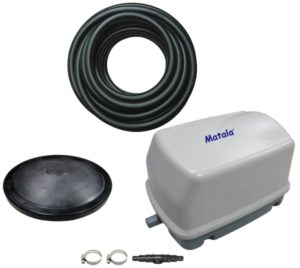
Pond aeration refers to having systems in your pond that increase the oxygen levels in the water. Any time that we can increase the oxygen levels in our water, it is a good thing—not only for our fish but also for our microbial community.
Here are some of the most common pond aeration systems that you might have in your pond:
- Waterfall – Any time that we pump water up and out of our ponds and allow it to fall back in, we are adding oxygen to the water.
- Fountain – If you have a floating fountain in your pond that shoots water into the air, this adds oxygen to your water.
- Bottom Aeration – Having an air pump on shore that pushes air down to the diffusers on the pond bottom is one of the best ways to add oxygen to your pond water.
- Oxygen Saturation Technology – If you have a larger pond or lake and you want the ultimate oxygenation tool, this is it. These are cutting edge aeration systems that can blanket the bottom of your pond with oxygen which is the ultimate solution to help clean up a dirty pond bottom.
Pond Bacteria
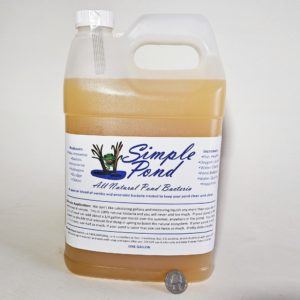
Adding supplemental pond bacteria to our ponds will help combat any imbalance that may occur. Additional bacteria will supplement the natural microbes in a pond and help to process excess nutrients from both internal and external sources. These beneficial microbes have a significant impact on the health of our pond. Keeping microbes happy creates safer water and better lives.
Nets and Rakes
We can certainly help restore balance by netting and raking debris out of the pond. If a large storm has dumped debris in your pond, spending an hour skimming out debris will undoubtedly help the pond recover more quickly. Every leaf, twig, and mulch piece that you skim out of your pond helps to remove nutrients from the pond. You can think of all that vegetative matter as fertilizer, because if you leave it in the pond, it will decay and release nutrients into your water.
Plants
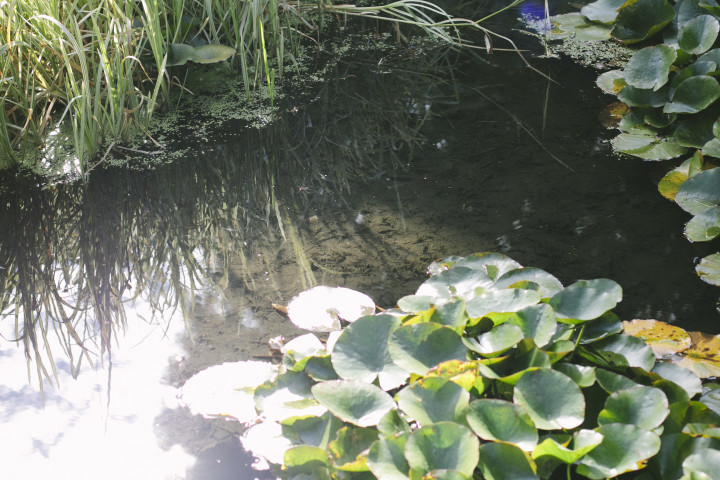
Having abundant and healthy aquatic plants growing in our pond will help the pond combat imbalance. Plants will work hard for us, removing both nutrients and chemicals from our pond water. I have found aquatic plants to be one of the most effective workhorses to remove nutrients from our pond water.
We Can Control Our Ecosystems
Variability and change are natural processes in aquatic ecosystems, and ecosystem communities and individual organisms have a remarkable ability to adapt to these changes, but humans can often cause changes that happen too quickly for the organisms to adapt. Pollution, changes to the landscape, chemical runoff, and larger-scale impacts such as global climate change all affect the ecosystem. Some of the worst contaminants that can enter our ponds are what they call endocrine-disrupting substances, such as agricultural pesticides, strong industrial detergents, hormones, and synthetic steroids.
Sometimes, the list of how we humans have affected our Earth’s ecosystem seems a bit overwhelming and we feel like we can’t do much about it. I’m here to tell you that change starts and happens gradually, person by person and yard by yard. We can certainly control our very own backyard ecosystem and we can do our best to avoid chemical usage and to protect all of the life that we can and can’t see.
We always treat all of our ponds naturally, so if you need someone to help you, or if you just want to ask a few questions, don’t hesitate to give us a call.

